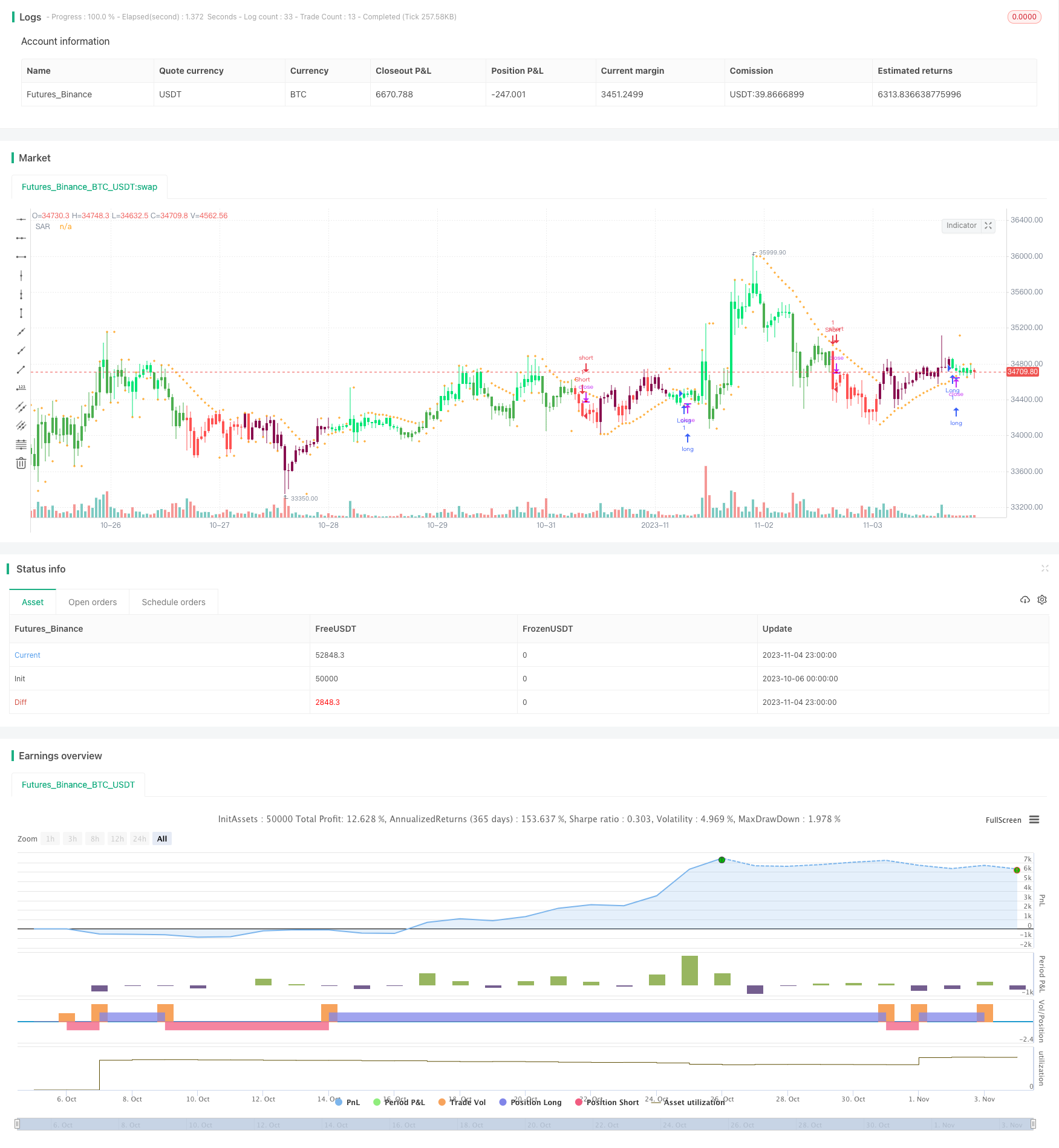
概述
该策略利用布林带、肯特纳通道和自适应相对强弱指标三种技术指标判断当前趋势方向,配合抛物线SAR指标进行入场。当三种指标判断结果一致时产生交易信号。策略主要判断趋势方向,在趋势发生变化时及时入场,目标获利。
原理
该策略使用以下三个技术指标组合判断当前趋势:
斯奎兹指标(SQUEEZE MOMENTUM INDICATOR):计算布林带和肯特纳通道,当两者叠加时产生压缩,表示趋势即将出现变化的信号。该指标返回压缩状态和线性回归曲线斜率。
自适应相对强弱指数(RSI VOLUME WEIGHTED):计算成交量加权的RSI,用中线判断超买超卖。该指标强调成交量变化。
抛物线停损(SAR):判断当前价格与抛物线SAR的位置关系,SAR在价格上方看跌,SAR在价格下方看涨。
策略使用布林带判定趋势方向,肯特纳通道refine,RSI判断超买超卖找反转机会,SAR指示入场时机。具体逻辑如下:
计算布林带、肯特纳通道、斯奎兹指标。斯奎兹压缩时进入准备阶段。
计算成交量加权RSI。RSI高于中线看涨,低于中线看跌。
计算抛物线SAR。SAR在价格下方则看涨,在价格上方则看跌。
综合上述三种指标:当斯奎兹压缩,RSI高于中线,SAR在价格下方时产生多头信号;当斯奎兹压缩,RSI低于中线,SAR在价格上方时产生空头信号。
信号产生时,判断前一个K线的三个指标判断结果,如果与当前信号判断相反,则产生入场信号。
入场后设置止损止盈,跟踪止损。
优势
该策略具有以下优势:
多指标组合看涨看跌,判断准确。斯奎兹指标识别趋势变化准确、RSI判断超买超卖明确、SAR指示入场时机精准。
指标逻辑简单清晰,容易理解实现。
采用多指标确认,可过滤假突破。
设置了止损止盈机制,可以锁定利润,控制风险。
回测数据充足,可靠性较高。
风险
该策略也存在一些风险:
多头和空头入场逻辑相似,可能同时发出反向信号,需要过滤。
三种指标均采用参数优化,可能过拟合。
交易次数可能过于频繁,要合理控制仓位数。
止损设置可能过于接近,容易被突破。
对应的解决方法:
增加指标结果持续周期判定,避免信号震荡。
采用 walk forward analysis 方法,调整参数,防止过拟合。
设置pyramid大小,控制单向持仓数量。
测试不同的止损区间,优化止损位置。
优化方向
该策略可以从以下几个方向进行优化:
优化指标参数,提高参数稳定性。可以考虑动态优化参数。
增加仓位控制逻辑,如大小仓、均仓等方式。
测试不同止损方式,如波动止损、线性止损、归零仓等。
增加money management功能,例如固定仓位、固定资金利用率等。
结合机器学习算法实现动态entrada和出场。
增加对冲机制,做多做空对冲,降低相关市场系统性风险。
考虑加入更多指标,建立投票机制,提高判断准确性。
总结
该策略整体思路清晰,利用多指标看涨看跌判断趋势方向,在布林带通道压缩时机敏锐入场,止损止盈机制控制风险,是一种较为稳定的趋势跟踪策略。通过参数优化、风控机制的改进,可以获得更好的回测指标和实盘效果。该策略适用于趋势较明显的品种,也可考虑在相对稳定的大周期如日线操作。整体来说,该策略具有较强的实用价值。
/*backtest
start: 2023-10-06 00:00:00
end: 2023-11-05 00:00:00
period: 1h
basePeriod: 15m
exchanges: [{"eid":"Futures_Binance","currency":"BTC_USDT"}]
*/
// This source code is subject to the terms of the Mozilla Public License 2.0 at https://mozilla.org/MPL/2.0/
// © XaviZ
//#####©ÉÉÉɶN###############################################
//####*..´´´´´´,,,»ëN########################################
//###ë..´´´´´´,,,,,,''%©#####################################
//###'´´´´´´,,,,,,,'''''?¶###################################
//##o´´´´´´,,,,,,,''''''''*©#################################
//##'´´´´´,,,,,,,'''''''^^^~±################################
//#±´´´´´,,,,,,,''''''''^í/;~*©####æ%;í»~~~~;==I±N###########
//#»´´´´,,,,,,'''''''''^;////;»¶X/í~~/~~~;=~~~~~~~~*¶########
//#'´´´,,,,,,''''''''^^;////;%I^~/~~/~~~=~~~;=?;~~~~;?ë######
//©´´,,,,,,,''''''''^^~/////X~/~~/~~/~~»í~~=~~~~~~~~~~^;É####
//¶´,,,,,,,''''''''^^^;///;%;~/~~;í~~»~í?~?~~~?I/~~~~?*=íÑ###
//N,,,,,,,'''''''^^^^^///;;o/~~;;~~;£=»í»;IX/=~~~~~~^^^^'*æ##
//#í,,,,,''''''''^^^^^;;;;;o~»~~~~íX//~/»~;í?IíI»~~^/*?'''=N#
//#%,,,'''''''''^^^^^^í;;;;£;~~~//»I»/£X/X/»í*&~~~^^^^'^*~'É#
//#©,,''''''''^^^^^^^^~;;;;&/~/////*X;í;o*í»~=*?*===^'''''*£#
//##&''''''''^^^^^^^^^^~;;;;X=í~~~»;;;/~;í»~»±;^^^^^';=''''É#
//##N^''''''^^^^^^^^^^~~~;;;;/£;~~/»~~»~~///o~~^^^^''''?^',æ#
//###Ñ''''^^^^^^^^^^^~~~~~;;;;;í*X*í»;~~IX?~~^^^^/?'''''=,=##
//####X'''^^^^^^^^^^~~~~~~~~;;íííííí~~í*=~~~~Ií^'''=''''^»©##
//#####£^^^^^^^^^^^~~~~~~~~~~~íííííí~~~~~*~^^^;/''''='',,N###
//######æ~^^^^^^^^~~~~~~~~~~~~~~íííí~~~~~^*^^^'=''''?',,§####
//########&^^^^^^~~~~~~~~~~~~~~~~~~~~~~~^^=^^''=''''?,íN#####
//#########N?^^~~~~~~~~~~~~~~~~~~~~~~~~^^^=^''^?''';í@#######
//###########N*~~~~~~~~~~~~~~~~~~~~~~~^^^*'''^='''/É#########
//##############@;~~~~~~~~~~~~~~~~~~~^^~='''~?'';É###########
//#################É=~~~~~~~~~~~~~~^^^*~'''*~?§##############
//#####################N§£I/~~~~~~»*?~»o§æN##################
//@version=4
strategy(title="M-SQUEEZE", overlay = true)
//study(title="M-SQUEEZE", overlay = true)
src = input(close, "SOURCE", type = input.source)
// ███▓▒░░ VARIABLES ░░▒▓███
var bool longCond = na, var bool shortCond = na
var int CondIni_long0 = 0, var int CondIni_short0 = 0
var int CondIni_long = 0, var int CondIni_short = 0
var float last_open_longCondition = na, var float last_open_shortCondition = na
var int last_longCondition0 = na, var int last_shortCondition0 = na
var int last_longCondition = na, var int last_shortCondition = na
var bool long_tp = na, var bool short_tp = na
var int last_long_tp = na, var int last_short_tp = na
var bool Final_Long_tp = na, var bool Final_Short_tp = na
var bool SMI_longCond = na, var bool SMI_shortCond = na
var bool RSI_longCond = na, var bool RSI_shortCond = na
var bool ADX_longCond = na, var bool ADX_shortCond = na
var bool SAR_longCond = na, var bool SAR_shortCond = na
var bool Final_longCondition0 = na, var bool Final_shortCondition0 = na
var bool Final_longCondition = na, var bool Final_shortCondition = na
// ███▓▒░░ SQUEEZE MOMENTUM INDICATOR ░░▒▓███
Act_SMI = input(true, "SQUEEZE MOMENTUM INDICATOR")
BB_length = input(85, title="BOLLINGER BANDS LENGTH", minval = 1)
BB_mult = input(2.1, title="BOLLINGER BANDS MULTI-FACTOR", minval = 0.1, step = 0.1)
KC_length = input(38, title="KELTNER CHANNEL LENGTH", minval = 1)
KC_mult = input(2.0, title="KELTNER CHANNEL MULTI-FACTOR", minval = 0.1, step = 0.1)
SQUEEZE_M(_src,_BB_length,_BB_mult,_KC_length,_KC_mult)=>
// Calculate BB
basis = sma(_src, _BB_length)
dev = _BB_mult * stdev(_src, _BB_length)
upperBB = basis + dev
lowerBB = basis - dev
// Calculate KC
ma = sma(src, _KC_length)
rangema = sma(tr, _KC_length)
upperKC = ma + rangema * _KC_mult
lowerKC = ma - rangema * _KC_mult
// Squeeze
sqzOn = lowerBB > lowerKC and upperBB < upperKC
sqzOff = lowerBB < lowerKC and upperBB > upperKC
nosqz = sqzOn == false and sqzOff == false
// Linear Regression curve
val = linreg(_src - avg(avg(highest(high, _KC_length), lowest(low, _KC_length)), sma(close, _KC_length)), _KC_length, 0)
[nosqz,val]
[NOSQZ,VAL] = SQUEEZE_M(src,BB_length,BB_mult,KC_length,KC_mult)
barcolor(iff(VAL > 0, iff(VAL > nz(VAL[1]), color.lime, color.green), iff(VAL < nz(VAL[1]), color.red, color.maroon)))
// ███▓▒░░ SAR ░░▒▓███
Act_SAR = input(true, "PARABOLIC SAR")
Sst = input (0.73, "SAR STAR", step=0.01, minval = 0.01)
Sinc = input (0.5, "SAR INC", step=0.01, minval = 0.01)
Smax = input (0.06, "SAR MAX", step=0.01, minval = 0.01)
SAR = sar(Sst, Sinc, Smax)
plot(SAR, style = plot.style_cross, title = "SAR")
// ███▓▒░░ RSI VOLUME WEIGHTED ░░▒▓███
Act_RSI = input(true, "RSI VOLUME WEIGHTED")
RSI_len = input(22, "RSI LENGHT", minval = 1)
RSI_obos = input(45,title="RSI CENTER LINE", type=input.integer, minval = 1)
WiMA(_src, _length)=>
var float MA_s=0.0
MA_s:=(_src + nz(MA_s[1] * (_length-1)))/_length
MA_s
RSI_Volume(fv, length)=>
up=iff(fv>fv[1],abs(fv-fv[1])*volume,0)
dn=iff(fv<fv[1],abs(fv-fv[1])*volume,0)
upt=WiMA(up,length)
dnt=WiMA(dn,length)
100*(upt/(upt+dnt))
RSI_V = RSI_Volume(src, RSI_len)
// ███▓▒░░ STRATEGY ░░▒▓███
SMI_longCond := (Act_SMI ? (VAL > 0 and (VAL > nz(VAL[1])) and not NOSQZ) : RSI_longCond)
RSI_longCond := (Act_RSI ? (RSI_V > RSI_obos) : SAR_longCond)
SAR_longCond := (Act_SAR ? (SAR < close) : SMI_longCond)
SMI_shortCond := (Act_SMI ? (VAL < 0 and (VAL < nz(VAL[1])) and not NOSQZ) : RSI_shortCond)
RSI_shortCond := (Act_RSI ? (RSI_V < RSI_obos) : SAR_shortCond)
SAR_shortCond := (Act_SAR ? (SAR > close) : SMI_shortCond)
longCond := SMI_longCond and RSI_longCond and SAR_longCond
shortCond := SMI_shortCond and RSI_shortCond and SAR_shortCond
CondIni_long0 := longCond ? 1 : shortCond ? -1 : CondIni_long0[1]
CondIni_short0 := longCond ? 1 : shortCond ? -1 : CondIni_short0[1]
longCondition0 = (longCond and CondIni_long0[1] == -1)
shortCondition0 = (shortCond and CondIni_short0[1] == 1)
CondIni_long := longCond[1] ? 1 : shortCond[1] ? -1 : CondIni_long[1]
CondIni_short := longCond[1] ? 1 : shortCond[1] ? -1 : CondIni_short[1]
longCondition = (longCond[1] and CondIni_long[1] == -1)
shortCondition = (shortCond[1] and CondIni_short[1] == 1)
// ███▓▒░░ ALERTS & SIGNALS ░░▒▓███
plotshape(longCondition, title = "Long Signal", style = shape.triangleup, location = location.belowbar, color = color.blue, transp = 0, size = size.tiny)
plotshape(shortCondition, title = "Short Signal", style = shape.triangledown, location = location.abovebar, color = #FF0000, transp = 0, size = size.tiny)
//alertcondition(longCondition, title="Long Alert", message = "LONG")
//alertcondition(shortCondition, title="Short Alert", message = "SHORT")
// ███▓▒░░ BACKTESTING ░░▒▓███
testStartYear = input(2018, "BACKTEST START YEAR", minval = 1980, maxval = 2222)
testStartMonth = input(01, "BACKTEST START MONTH", minval = 1, maxval = 12)
testStartDay = input(01, "BACKTEST START DAY", minval = 1, maxval = 31)
testPeriodStart = timestamp(testStartYear,testStartMonth,testStartDay,0,0)
testStopYear = input(2222, "BACKTEST STOP YEAR", minval=1980, maxval = 2222)
testStopMonth = input(12, "BACKTEST STOP MONTH", minval=1, maxval=12)
testStopDay = input(31, "BACKTEST STOP DAY", minval=1, maxval=31)
testPeriodStop = timestamp(testStopYear, testStopMonth, testStopDay, 0, 0)
testPeriod = time >= testPeriodStart and time <= testPeriodStop ? true : false
strategy.entry("Long", strategy.long, when = longCondition0 and testPeriod)
strategy.entry("Short", strategy.short, when = shortCondition0 and testPeriod)